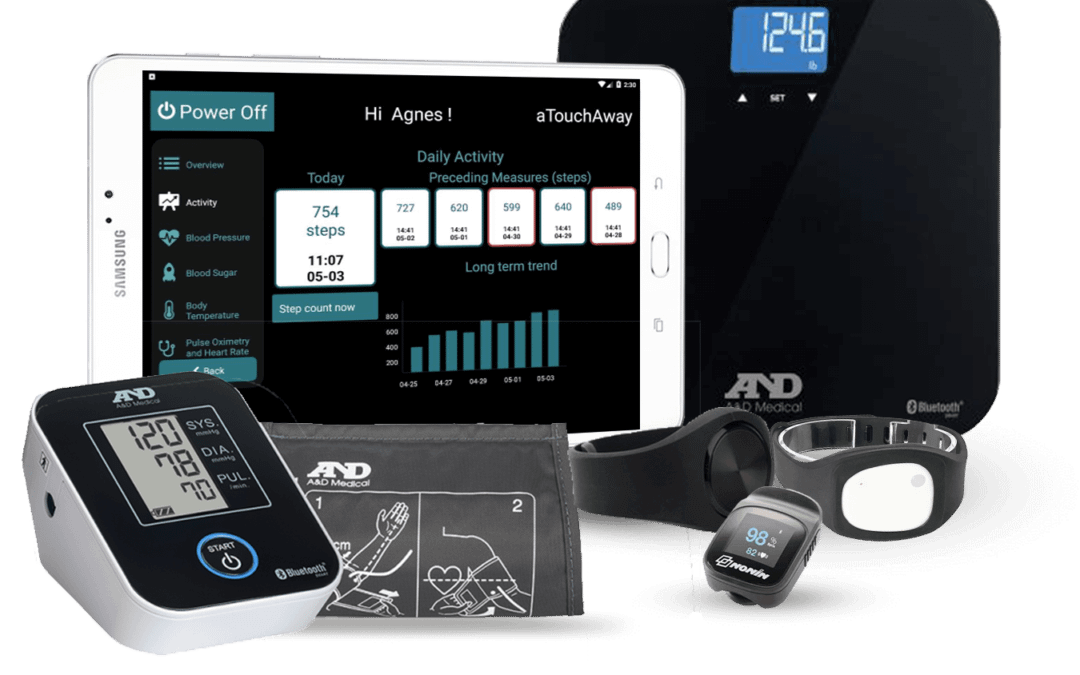Having multiple illnesses or conditions to manage can be exhausting. It’s even more challenging for healthcare professionals who are tasked with caring for many of these patients at once. Fortunately, it is possible for even the most complex patients to be more proactive with their health.
Remote patient management can be used for a wide range of health conditions, including chronic diseases such as diabetes, hypertension, heart failure, chronic obstructive pulmonary disease (COPD), and asthma. It can also be used for post-surgical monitoring.
Devices such as wearables (ex. a fall detection bracelet on your wrist) or in-home diagnostic devices, provide the ability to easily track the patient’s vital health indicators over time, analyze patterns and take action. These devices can be easy-to-use as simple as pressing a button but can save the patient a visit to the doctor.
Pedometers
Step counters are used for many purposes – one of the main uses being for post-operative care. After a patient is discharged from the hospital, they will typically be given a list of what to do and what not to do. Often times, these instructions will include getting a certain amount of exercise every day. When their care providers are able to monitor their activity through a step counting device, care givers can ensure that the patient is getting the correct amount of physical activity. Another key use for step counters are for people with Chronic Obstructive Pulmonary Disease (COPD) -as regular exercise strengthens their muscles and helps them be less short of breath. A study from the US National Library of Medicine shows that COPD patients completing a physical activity enhancement program using a pedometer reported back an overall improved physical activity level and quality of life.
Safety Wearables
87% of injuries to the elderly are caused by falls – that’s a lot of injuries that could be easily prevented. A discrete bracelet or pendant with fall detection capabilities can make all the difference in a timely response to a fall. Fall detection devices have the ability to recognize when the user has fallen and automatically alert the appropriate people. A quality fall detection device will be durable, waterproof, and very easy to use. When connected to certain software applications, the user can simply tap a button on the bracelet to immediately initiate a call for help – also useful as a call bell in a hospital or care facility environment. A bracelet that detects physical activities can also be used to track patient movement/activity levels. Another common risk among older patients is wandering. In fact, studies show that 60% of people with Alzheimer’s will wander. If the patient is not found within 24 hours, up to half of them suffer serious injury or death. Be sure to look for a device that can detect both falls and wandering that offers patients a discrete mechanism for personal safety.
Pulse Oximeter
A pulse oximeter is a small device usually worn on the patient’s finger, that can measure how much oxygen is in the patient’s blood along with measuring their heart rate. This type of device is typically used by those with illnesses that compromise the body’s ability to take in and circulate oxygen – like COPD, congestive heart failure, and asthma. Pulse oximeters are extremely easy-to-use and completely painless, the patient can simply clip it onto their fingertip and get their reading. Results can be viewed by the patient themselves and their care team to continue monitoring their condition. When a pulse oximeter is connected to software, patients and care providers can also track how results have improved from past tests as well.
Weight Scale
Medical quality weight scales can always be found in any hospital or doctor’s office. When the patient’s health is at risk, their care provider might suggest they lose weight. Patients with COPD or heart failure can benefit greatly from weight loss. Fortunately, patients can now weigh themselves properly outside of their doctor’s office. Today’s technologies have made “smart” weight scales available for home use that can also be integrated with software programs to automatically share results with others caring for them.
Blood Pressure
Blood pressure is another vital sign that can be self-monitored through technology. There are various devices on the market today that have the ability to connect to a mobile tablet or cell phone to capture and track results. These blood pressure devices are designed to be easy to put on, set up and use – allowing patients to measure their blood pressure anytime from the comfort of their own homes. If the device is set up to run with the right app, all of their care providers can view their results without anyone having to visit a doctor’s office, care clinic or hospital. This saves time for patients, care providers and physicians and allows the patient to check on their condition whenever they want.
It is clear that in-home diagnostic devices and wearables are becoming more and more applicable for those with conditions that need to be monitored. In fact, it’s expected that by the end of 2018, 130 million wearables will have been shipped out. Finding the app with the right functionalities that provides seamless interoperability is important when using any of these healthcare devices. Everyone caring for the patient will benefit when they can all be easily updated on their condition.
Image courtesy of The Doctor Weighs In

